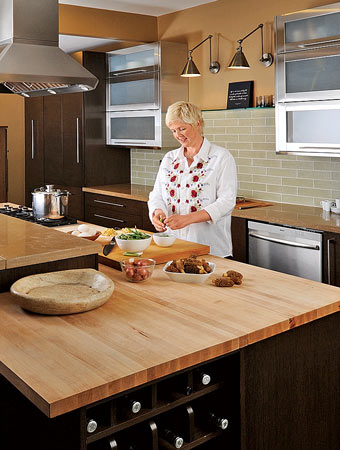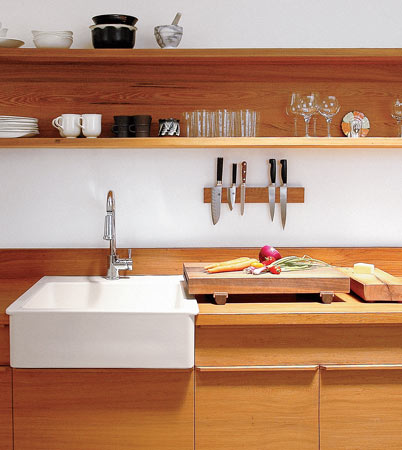Q: I love the idea of a wood countertop in a kitchen, but with all the different types, finishes, and maintenance recommendations, how do I find one that’s right for me?
A:Interest in wood countertops is surging, and we have our suspicions as to why. While granite and other stones popular in recent years generally require little maintenance, they’re not exactly warm to the eye or the elbow. A wood countertop is cozier and more informal. Something about the material seems to encourage easy conversation as guests and family lean in, helping themselves to wine and nibbles from your prep area.
“I consider introducing wood countertops when a kitchen needs an element of casualness and relaxation and a warm feel. Wood is approachable,” says Summer Thornton of Summer Thornton Design. She especially likes reclaimed woods for their patina and character.
These days there are all kinds of options, including butcher block, salvaged wood, exotic species, and many different stains and sealers. Here’s a primer.

Chef Shelley Young, owner of The Chopping Block, maintains her Boos maple countertop with
regular cleaning and oiling and uses a separate board for actual chopping.
First, be clear in your mind about whether the area you’re setting up is specifically for cutting and chopping or for food preparation that doesn’t involve knives. Or maybe you want a furniture-like piece, more for beauty than kitchen rough-and-tumble. One caveat about wood countertops is that you need to be on the alert for people who aren’t sensitive to the differences and may start slicing bagels in the middle of your beautiful walnut countertop.
Cutting boards and chopping blocks exist for good reason: They get scratched and dinged and acquire a well-worn look from hard use so that your other surfaces do not. Make sure anyone in your kitchen with a knife in his or her hand understands where the approved-for-chopping area is.
Next, consider the two main options for wood countertop finishes. A sealed surface—sometimes called glazed or lacquered and often factory finished—is essentially water- proof and stain-proof and requires almost no maintenance. Whether the effect is accomplished with varnish, polyurethane, or another material, sealed countertops are not intended as workspaces, says Becky Hewing, sales manager for kitchen countertops at John Boos, a 125-year-old firm that has manufactured wood workstations for many local restaurants, including Blackbird. “If you’re going to slice and dice, you have to have an oil-finished block instead of a sealed block,” she says.
A natural oil finish is safe for direct knife work but requires cleaning and oiling on a regular basis. Chef Shelley Young, founder and owner of The Chopping Block, uses Boos butcher-block counters for preparing and serving food in her home kitchen but does her chopping on a separate board of the same material. She cleans the wood surfaces with a green scrubber sponge dipped in soap and water (removing stains with a capful of bleach per gallon of water) before putting on rubber gloves and working in mineral oil.
Unsealed wood counters can be sanded to eliminate gouges, burn marks, or serious stains, though sanding is not recommended, much less required, for general maintenance. The surface should be reoiled after sanding. Speaking of burns, never put hot pots and pans down on a wood surface; always use a trivet or hot pad, regardless of the finish.

End-grain butcher block surrounds a farmhouse sink in a kitchen by
Christine Julian and interior designer Michael Del Piero.
Christine Julian, president of Julian Kitchen Design, likes to use end-grain blocks for clients who want a high-traffic workspace. “End-grain” refers to the vertical grain orientation of the wood within the chopping block (think of the cross section of a tree trunk). It is much denser than edge-grain (horizontal) wood, so it can take lots of knife action. It’s also kinder to knife blades, because you’re cutting with the grain instead of against it. And end-grain blocks can be lovely to look at.
Contrary to what many people think about wood counters (or wood cutting boards, for that matter), if they’re well cared for, they don’t absorb or harbor any more bacteria than harder surfaces do. Studies have shown that wood has natural antibacterial properties. The key to a sanitary kitchen is cleaning and moisturizing the counter, Young says. “If wood is properly treated and maintained, it doesn’t really absorb the odors and stains the way it would if it were dry.”
Oiling is important, says designer and woodworker Peter Dunham, cofounder of the design company Uusi. He put a veneer of cypress planks, reclaimed from old water towers, in his kitchen three years ago and has also installed walnut kitchen counters for residential clients. “For the first two weeks, you want to oil unsealed work surfaces pretty often,” he says. Once the oil has penetrated, the counters require little maintenance, though Dunham warns that you still need to be wary of standing water—wood’s enemy.

A cutting board sits on the cypress veneer countertop in Uusi cofounder Peter Dunham’s kitchen.
Because even well-conditioned wood expands when drenched, some designers use less permeable materials around sinks. Claudia Skylar of Mastro & Skylar Architects likes to install low-maintenance CaesarStone in the sink area and integrate butcher block into islands or workstation chopping areas. "A kitchen is a collage of many materials, and very often it’s nice to work in a wood," she says. Skylar sometimes likes to paint the lower cabinetry of a wood-topped island, as she did recently in a kitchen that had walnut cabinets and a matching island topper.
Julian also often mixes and matches woods in a kitchen, believing that utility directs design. "I’ll use more than one kind within the same island—do a small section of end-grain for a cutting board, surrounded by sealed edge-grain or stone," she says.
An endless variety of looks can be achieved with wood counters, as the material’s natural colorations allow most designers to use wood without staining it. As a chef, Young prefers completely organic and untreated wood surfaces in the classroom kitchens of her cookware store because she uses the counters as giant workstations. Dunham eschews staining because any nicks penetrating deeper than the tinted layer will show the true color of the wood underneath, making damage more visible. "If something is stained, it’s going to wear differently. If you want a dark-wood look, use a dark wood, like walnut," he says.
Natural variations that occur in wood allow clients to choose a material that suits their design aesthetic, and Julian says that finishing the counter in a certain way will really drive its appearance. Small details such as an ogee (slightly S-shaped) edge can make a counter seem more formal, whereas a sharper corner reads modern.
"For a contemporary look, cut a square edge and choose a more monotone species," Julian suggests. Woods with relatively uniform color and unshowy grain include oak, maple, Brazilian cherry, and sapele. For "movement" and drama, her clients have opted for woods with more prominent grains and colorations, such as hickory, zebrawood, and walnut that includes streaks of lighter-colored sapwood.
photograph (shelley young) bob coscarelli
photograph (Christine Julian Michael Del Piero kitchen) nathan kirkman
Have a design or renovation question?
E-mail us at chicagohome@chicagomag.com and we’ll do our best to answer. Sorry, we cannot take questions by phone or guarantee individual responses. We might already have an answer for you—check out our Expert Advice archive at chicagohomemag.com.



